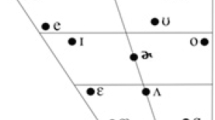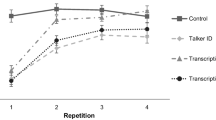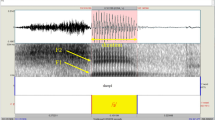Abstract
Cognitive attention control guides auditory processes during speech processing but its contribution to L2 speech learning remains under-researched. This study examined the interaction between individual differences in auditory selective attention (ASA) and attention switching (ASW), and the effectiveness of high-variability phonetic training (HVPT) administered under different stimuli and presentation conditions to improve L2 learners’ sensitivity to an L2 vowel contrast and its lexical encoding. Catalan-Spanish bilingual adult learners of English (N = 102) were randomly assigned to eight HVPT groups and trained in four 35-min sessions on the perception and production of English /æ/ and /ʌ/ through identification, discrimination, and immediate repetition tasks. Learners’ gains were assessed through ABX discrimination and delayed word repetition tasks. Lexical encoding was tested through lexical decision and delayed sentence repetition tasks. We measured ASA through a single-talker competition paradigm and ASW through a novel speech-based version of the alternating-runs task-switching paradigm. Results showed that ASA was often related to pre-test (T1) and post-test (T2) perception accuracy but unrelated to either production accuracy or T1-T2 perceptual and production gains. However, ASW was related to /æ/ and /ʌ/ perception and production gains, but this varied as a function of stimuli type and presentation condition.
Access this chapter
Tax calculation will be finalised at checkout
Purchases are for personal use only
Similar content being viewed by others
References
Astheimer, L. B., Berkes, M., & Bialystok, E. (2016). Differential allocation of attention during speech perception in monolingual and bilingual listeners. Language, Cognition and Neuroscience, 31(2), 196–205. https://doi.org/10.1080/23273798.2015.1083114
Best, C. T. (2011). Devil or angel in the details? Perceiving phonetic variation as information about phonological structure. In J. Romero & M. Riera (Eds.), The phonetics-phonology interface: Representations and methodologies (pp. 3–32). John Benjamins. https://dx.doi.org/10.1075/cilt.335.01bes
Boersma, P., & Weenink, D. (2020). Praat: Doing phonetics by computer (Version 6.1.09) [Computer software].
Bohn, O. S., & Flege, J. E. (1990). Interlingual identification and the role of foreign language experience in L2 vowel perception. Applied Psycholinguistics, 11(3), 303–328. https://doi.org/10.1017/S0142716400008912
Bradlow, A. R. (2008). Training non-native language sound patterns: Lessons from training Japanese adults on the English /r/-/l/ contrast. In J. G. Hansen Edwards & M. L. Zampini (Eds.), Phonology and second language acquisition (pp. 287–308). John Benjamins. https://dx.doi.org/10.1075/sibil.36.14bra
Carlet, A., & Cebrian, J. (2019). Assessing the effect of perceptual training on L2 vowel identification, generalization and long-term effects. In A. M. Nyvad, M. Hejná, A. Højen, A. B. Jespersen, & M. H. Sørensen (Eds.), A sound approach to language matters: In honor of Ocke-Schwen Bohn (pp. 91–119). Aarhus University. https://dx.doi.org/10.7146/aul.322.218
Cebrian, J. (2006). Experience and the use of duration in the categorization of L2 vowels. Journal of Phonetics, 34(3), 372–387. https://doi.org/10.1016/j.wocn.2005.08.003
Cebrian, J. (2019). Perceptual assimilation of British English vowels to Spanish monophthongs and diphthongs. Journal of the Acoustical Society of America, 145(1), EL52–EL58. https://dx.doi.org/10.1121/1.5087645
Cebrian, J., Mora, J. C., & Aliaga-Garcia, C. (2011). Assessing crosslinguistic similarity by means of rated discrimination and perceptual assimilation tasks. In M. Wrembel, M. Kul, & K. Dziubalska-Kołaczyk (Eds.), Achievements and perspectives in SLA of speech, New Sounds 2010 (Vol. 1, pp. 41–52). Peter Lang. ISBN: 9783631607220
Cooke, M., & Garcia-Lecumberri, M. (2018). Effects of exposure to noise during perceptual training of non-native language sounds. The Journal of the Acoustical Society of America, 143(5), 2602–2610. https://doi.org/10.1121/1.5035080
Darcy, I., Mora, J. C., & Daidone, D. (2014). Attention control and inhibition influence phonological development in a second language. Proceedings of the 7th International Symposium on the Acquisition of Second Language Speech, New Sounds 2013: Concordia Working Papers in Applied Linguistics, 5, 115–129. https://hdl.handle.net/2022/22863
Draine, S. (1999). Inquisit (Version 5.0.14.0) [Computer software]. Millisecond Software. https://www.millisecond.com/
Flege, J. E. (2009). Give input a chance! In T. Piske & M. Young-Scholten (Eds.), Input matters in SLA (pp. 175–190). Multilingual Matters.
Forster, K. I., & Forster, J. C. (2003). DMDX: A Windows display program with millisecond accuracy. Behavior Research Methods, 35(1), 116–124. https://doi.org/10.3758/BF03195503
Ghaffarvand Mokari, P., & Werner, S. (2019). On the role of cognitive abilities in second language vowel learning. Language and Speech, 62(2), 260–280. https://doi.org/10.1177/0023830918764517
Golestani, N., & Zatorre, R. J. (2009). Individual differences in the acquisition of a second language phonology. Brain and Language, 109(2–3), 55–67. https://doi.org/10.1016/j.bandl.2008.01.005
Gurzynski-Weiss, L., Long, A. Y., & Solon, M. (2017). TBLT and L2 pronunciation: Do the benefits of tasks extend beyond grammar and lexis? Studies in Second Language Acquisition, 39(2), 213–224. https://doi.org/10.1017/S0272263117000080
Hardison, D. M. (2018). Effects of contextual and visual cues on spoken language processing: Enhancing L2 perceptual salience through focused training. In S. M. Gass, P. Spinner, & J. Behney (Eds.), Salience in second language acquisition (pp. 201–220). Routledge.
Hazan, V., & Baker, R. (2011). Acoustic-phonetic characteristics of speech produced with communicative intent to counter adverse listening conditions. The Journal of the Acoustic Society of America, 130(4), 2139–2152. https://doi.org/10.1121/1.3623753
Hazan, V., Sennema, A., Iba, M., & Faulkner, A. (2005). Effect of audiovisual perceptual training on the perception and production of consonants by Japanese learners of English. Speech Communication, 47(3), 360–378. https://doi.org/10.1016/j.specom.2005.04.007
Humes, L. E., Lee, J. H., & Coughlin, M. P. (2006). Auditory measures of selective and divided attention in young and older adults using single-talker competition. The Journal of the Acoustical Society of America, 120(5), 2926–2937. https://doi.org/10.1121/1.2354070
Iverson, P., Hazan, V., & Bannister, K. (2005). Phonetic training with acoustic cue manipulations: A comparison of methods for teaching English/r/-/l/to Japanese adults. The Journal of the Acoustical Society of America, 118(5), 3267–3278. https://doi.org/10.1121/1.2062307
Kartushina, N., Hervais-Adelman, A., Frauenfelder, U. H., & Golestani, N. (2015). The effect of phonetic production training with visual feedback on the perception and production of foreign speech sounds. The Journal of the Acoustical Society of America, 138(2), 817–832. https://doi.org/10.1121/1.4926561
Kim, Y. H., & Hazan, V. (2010). Individual variability in the perceptual learning of L2 speech sounds and its cognitive correlates. In K. Dziubalska-Kołaczyk, M. Wrembel, & M. Kul (Eds.), Proceedings of the 6th International Symposium on the Acquisition of Second Language Speech, New Sounds 2010 (pp. 251–256). Poznań, Poland. ISBN: 978-83-928167-9-9
Kormos, J. (2017). The effects of specific learning difficulties on processes of multilingual language development. Annual Review of Applied Linguistics, 37, 30–44. https://doi.org/10.1017/S026719051700006X
Lev-Ari, S., & Peperkamp, S. (2014). The influence of inhibitory skill on phonological representations in production and perception. Journal of Phonetics, 47, 36–46. https://doi.org/10.1016/j.wocn.2014.09.001
Mattys, S. L., Davis, M. H., Bradlow, A. R., & Scott, S. K. (2012). Speech recognition in adverse conditions: A review. Language and Cognitive Processes, 27(7–8), 953–978. https://doi.org/10.1080/01690965.2012.705006
Meara, P. M., & Miralpeix, I. (2006). Y_Lex: The Swansea advanced vocabulary levels test (Version 2.05) [Computer Software]. Lognostics. https://www.lognostics.co.uk/tools/
Miyake, A., & Friedman, N. P. (2012). The nature and organization of individual differences in executive functions: Four general conclusions. Current Directions in Psychological Science, 21(1), 8–14. https://doi.org/10.1177/0963721411429458
Mora, J. C., & Levkina, M. (2017). Task-based pronunciation teaching and research: Key issues and future directions. Studies in Second Language Acquisition, 39(2), 381–399. https://doi.org/10.1017/S0272263117000183
Mora, J. C., & Mora-Plaza, I. (2019). Contributions of cognitive attention control to L2 speech learning. In A. M. Nyvad, M. Hejná, A. Højen, A. B. Jespersen, & M. H. Sørensen (Eds.), A sound approach to language matters: In honor of Ocke-Schwen Bohn (pp. 477–499). Aarhus University. https://dx.doi.org/10.7146/aul.322.218
Mora-Plaza, I., Mora, J. C., & Gilabert, R. (2018). Learning L2 pronunciation through communicative tasks. In J. Levis (Ed.), Proceedings of the 9th Pronunciation in Second Language Learning and Teaching Conference, ISSN 2380-9566, University of Utah, September, 2017 (pp. 174–184). Ames, IA: Iowa State University.
Moyer, A. (2014). What’s age got to do with it? Accounting for individual factors in second language accent. Studies in Second Language Learning and Teaching, 4(3), 443–464. https://dx.doi.org/10.14746/ssllt.2014.4.3.4
Munro, M. J., & Bohn, O.-S. (2007). The study of second language speech: A brief overview. In O.-S. Bohn & M. J. Munro (Eds.), Language experience, second language learning: In honor of James Emil Flege (pp. 3–11). John Benjamins. https://dx.doi.org/10.1075/lllt.17.06mun
Ortega, L., Iwashita, N., Norris, J. M., & Rabie, S. (2002, October 3–6). An investigation of elicited imitation tasks in crosslinguistic SLA research [Conference presentation]. Second Language Research Forum, Toronto, Canada.
Ortega, M., Mora-Plaza, I., & Mora, J. C. (2021). Differential effects of lexical and non-lexical high-variability phonetic training on the production of L2 vowels. In A. Kirkova-Naskova, A. Henderson, & J. Fouz-González (Eds.), English pronunciation instruction: Research-based insights (pp. 328–355). John Benjamins. https://dx.doi.org/10.1075/aals.19.14ort
Ou, J., Law, S. P., & Fung, R. (2015). Relationship between individual differences in speech processing and cognitive functions. Psychonomic Bulletin & Review, 22(6), 1725–1732. https://dx.doi.org/10.3758/s13423-015-0839-y
Rallo-Fabra, L., & Romero, J. (2012). Native Catalan learners’ perception and production of English vowels. Journal of Phonetics, 40(3), 491–508. https://doi.org/10.1016/j.wocn.2012.01.001
Sadakata, M., & McQueen, J. M. (2013). High stimulus variability in nonnative speech learning supports formation of abstract categories: Evidence from Japanese geminates. The Journal of the Acoustical Society of America, 134(2), 1324–1335. https://doi.org/10.1121/1.4812767
Safronova, E., & Mora, J. C. (2013). Attention control in L2 phonological acquisition. In A. Llanes Baró, L. Astrid Ciro, L. Gallego Balsà, & R. M. Mateus Serra (Eds.), Applied linguistics in the age of globalization (pp. 384–390). Edicions de la Universitat de Lleida.
Saito, K., Kachlicka, M., Sun, H., & Tierney, A. (2020). Domain-general auditory processing as an anchor of post-pubertal L2 pronunciation learning: Behavioural and neurophysiological investigations of perceptual acuity, age, experience, development, and attainment. Journal of Memory and Language, 115, 104168. https://doi.org/10.1016/j.jml.2020.104168
Segalowitz, N., & Frenkiel-Fishman, S. (2005). Attention control and ability level in a complex cognitive skill: Attention shifting and second-language proficiency. Memory & Cognition, 33(4), 644–653. https://doi.org/10.3758/BF03195331
Shinohara, Y., & Iverson, P. (2018). High variability identification and discrimination training for Japanese speakers learning English/r/–/l. Journal of Phonetics, 66, 242–251. https://doi.org/10.1016/j.wocn.2017.11.002
Solon, M., Long, A. Y., & Gurzynski-Weiss, L. (2017). Task complexity, language-related episodes, and production of L2 Spanish vowels. Studies in Second Language Acquisition, 39(2), 347–380. https://doi.org/10.1017/S0272263116000425
Thomson, R. I. (2011). Computer assisted pronunciation Training: Targeting second language vowels: Perception improves pronunciation. CALICO Journal, 28(3), 744–765. https://dx.doi.org/10.11139/cj.28.3.744-765
Thomson, R. I. (2018). English Accent Coach (Version 2.3) [Computer software]. https://www.englishaccentcoach.com/
Thomson, R. I., & Derwing, T. M. (2016). Is phonemic training using nonsense or real words more effective? In J. Levis, H. Le., I. Lucic, E. Simpson, & S. Vo (Eds.), Proceedings of the 7th Pronunciation in Second Language Learning and Teaching Conference, ISSN 2380-9566, Dallas, TX, October 2015 (pp. 88–97). Ames, IA: Iowa State University.
Tyler, M. D. (2019). PAM-L2 and phonological category assimilation in the foreign language classroom. In A. M. Nyvad, M. Hejná, A. Højen, A. B. Jespersen, & M. H. Sørensen (Eds.), A Sound approach to language matters: In honor of Ocke-Schwen Bohn (pp. 607–630). Aarhus University. https://dx.doi.org/10.7146/aul.322.218
Wong, J. W. S. (2013). The effects of perceptual and/or productive training on the perception and production of English vowels /ɪ/ and /iː/ by Cantonese ESL learners. In F. Bimbot, C. Cerisara, C. Fougeron, G. Gravier, L. Lamel, P. Pellegrino, & P. Perrier (Eds.), Proceedings of the 14th Annual Conference of the International Speech Communication Association, Interspeech 2013 (pp. 2113–2117). ISCA.
Author information
Authors and Affiliations
Corresponding author
Editor information
Editors and Affiliations
Rights and permissions
Copyright information
© 2022 The Author(s), under exclusive license to Springer Nature Switzerland AG
About this chapter
Cite this chapter
Mora-Plaza, I., Ortega, M., Mora, J.C. (2022). High-Variability Phonetic Training Under Different Conditions: Individual Differences in Auditory Attention Control. In: Sardegna, V.G., Jarosz, A. (eds) Theoretical and Practical Developments in English Speech Assessment, Research, and Training. Second Language Learning and Teaching. Springer, Cham. https://doi.org/10.1007/978-3-030-98218-8_14
Download citation
DOI: https://doi.org/10.1007/978-3-030-98218-8_14
Published:
Publisher Name: Springer, Cham
Print ISBN: 978-3-030-98217-1
Online ISBN: 978-3-030-98218-8
eBook Packages: EducationEducation (R0)




